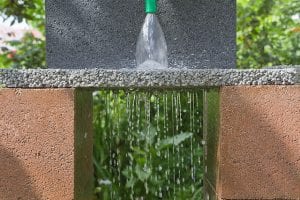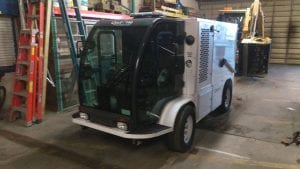The Public Works Department of the City of Bellingham gathers each morning in a grey walled, utilitarian lunch room. Along the north wall there is a shared kitchen complete with a fridge and two Keurigs. On the opposite wall are white boards where the day’s assignments are posted. Windows show a preview of the wet and windy weather that awaits the workers once the clock reaches 7:30 a.m. On the second whiteboard from the right, white magnets with black lettering represent each of the Stormwater Department’s fulltime employees. It was an overcast late fall day when I checked the whiteboard and saw that I would be working with Chad Abbott, cleaning pervious sidewalks.

Issues arise whenever man interjects its bulky physique into one of nature’s systems. The flow of storm water is usually self-regulated by our planet. The addition of cities and blankets of impermeable surfaces requires that we fix a problem we created. Without proper management, water would regroup with our oceans heavily contaminated and polluted. Along its path it would flood homes and farms, wash away driveways and hillsides, and create problematic standing puddles and flooded roads. This is why every large city employs a variety of storm water management tactics to try to keep humans and rain living in harmony, rather than discord.
One technique is to reduce the amount of impermeable surfaces, which include: concrete, asphalt, roofs, and other watertight materials. These surfaces force water to run off in sheets and negates the filtering and slowing abilities of soil. Surface water, what you see running along the road, is undesirable. Permeable surfaces, which allow water to percolate through to the subsurface have shown to be great replacements for their impermeable counterparts.
Chad and I headed out to Northshore Rd. where we would be using the city’s “Zamboni,” a specialized compact surface cleaner, to restore clogged permeable sidewalks and bike lanes. Before the zamboni, city workers had to lug out pressure washers and special vacuums to fight a losing battle. The zamboni makes it possible for a two man team to tackle whole lengths of sidewalk in a fraction of the time. Even though sidewalk cleaning may not pique the interest of many, I was looking forward to seeing this strange miniature street sweeper in action.

While we prepped the machine and surveyed where we would be cleaning, I got to know a little more about Chad. A loving father of four, Chad was born and raised right here in Bellingham, WA. For a brief spell he left the confines of the Pacific Northwest for Athens, Georgia but it wasn’t long until he felt the call to return home.
In 2002, after doing custodial work in the city, Chad joined on at Public Works. It was only a few years before he joined on that Bellingham first really started to see alternative permeable surfaces being installed. Now you can find the surfaces everywhere, way too much for the city to keep track of. Even with the help of the zamboni, the few sections that need to be cleaned are hard to maintain. Some, like the sidewalks along Bill McDonald, are nearly impossible to keep clean due to the tree coverage. Luckily for me, the sidewalk I found myself cleaning on Northshore is one of the easier ones to manage.
The process of cleaning is fairly straightforward. One person uses a leaf blower to remove large debris, while the other drives the zamboni which uses a combination of pressure washers, brushes and a powerful vacuum, to remove soil and debris that has been ground into the pervious. During the drier seasons, Chad and other city workers are constantly running the zamboni to try and complete the assigned cleanings. The city purchased the zamboni in 2015, and it has definitely put in enough work to become part of the team.

The work Chad does to keep the sidewalks clean is something that if done right will go unnoticed by almost all. Despite this, he takes pride in returning the sidewalks to an effective state. While I worked with him he showed a remarkable attention to detail and a keen sense of the level of contamination in the porous material. Keeping the sidewalks clean to maximize their effectiveness benefits our water quality, slows the flow of run off, and decreases standing water.
Next time you are out for a walk, take a moment to look at what’s beneath your feet. If the sidewalk you are walking on appears more porous like the concrete pictured, chances are that it’s pervious. If it happens to be raining, and Chad has taken a crack at that section of sidewalk, you’ll be able to see the water slowly disappear into the ground below. Who knows, maybe you’ll be walking the sidewalk I cleaned.










































